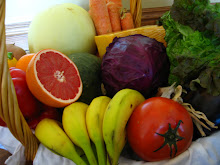We all know that we should increase the amount of produce in our diet. But hey, I eat spaghetti three times a week and the sauce counts, right? And I even occasionally throw in some corn and peas.
While this diet is not void of vegetables, it could certainly use some improvement. Most people should get 5-9 servings of fruits and vegetables every day. And it shouldn't be the same food over and over. Produce is good for you because it has a high nutrient to calorie ratio, is packed with antioxidants, fiber, vitamins, and minerals, and contains phytochemicals that are good for you, but not yet considered essential nutrients. These components work together to produce health benefits that can't be imitated by a multivitamin or other pill.
Variety is important because each fruit and vegetable has a different set of nutrients and phytochemicals that are important for your health in different ways. The most current research has focused on the compounds that give a fruit or vegetable its color. So the easiest way to diversify your nutrient intake is to eat a variety of colorful produce. Use the guide below to help you.
RED
The red pigment is produced by the natural plant pigments lycopene and anthocyanin. Red fruits and vegetables also contain ellagic acid, quercetin, and hesperidin. These compounds may help reduce the risk of several types of cancer, particularly lung, stomach, and prostate cancer, are potent antioxidants that can protect cells from damage, and may reduce blood pressure and LDL cholesterol levels.
Some examples of red produce include red apples, beets, red cabbage, cherries, cranberries, pink/red grapefruit, red grapes, guava, red onions, blood oranges, red pears, red peppers, pomegranates, red potatoes, radicchio, radishes, raspberries, rhubarb, strawberries, tomatoes, and watermelon.
ORANGE and YELLOW
Orange and yellow pigments typically come from carotenoids, specifically beta-carotene. This color of produce also contains zeaxanthin, lycopene, and various flavenoids. Once consumed, beta-carotene is converted into vitamin A by the body to help maintain healthy mucous membranes and eyes, improve immune function, and help reduce the risk of cancer and heart disease. The other compounds are good for your joints, encourage alkaline balance, and work with magnesium and calcium to promote healthy bones.
Examples include yellow apples, apricots, yellow beets, butternut squash, cantaloupe, yellow figs, cape gooseberries, carrots, golden kiwifruit, grapefruit, lemons, mangos, nectarines, oranges, papayas, peaches, pears, yellow peppers, persimmons, pineapple, yellow potatoes, pumpkin, rutabagas, yellow summer squash, yellow winter squash, sweet corn, sweet potatoes, tangerines, yellow tomatoes, and yellow watermelon.
GREEN
Did your mom ever tell you to eat your Brussels sprouts? Well that's because they are full of chlorophyll, which along with lutein, zeaxanthin, indoles, and folate helps keep eyes healthy, reduces the risk of cancer, optimizes digestion, boosts the immune system, and helps prevent birth defects. But remember there are more greens than lettuce, peas, and broccoli!
Give one of these a try at your next meal: green apples, arugula, artichokes, asparagus, avocados, green beans, green cabbage, celery, chayote squash, Chinese cabbage, cucumbers, endives, green grapes, honeydew melon, kiwi, leeks, limes, okra, green onions, green pears, green peppers, spinach, watercress, or zucchini.
BLUE and PURPLE
Blue and purple colors are from anthocyanins. They also contain resveratrol, zeaxanthin, flavenoids, ellagic acid, quercitin, and lutein. Together these compounds help improve mineral absorption, memory function and healthy aging, fight inflammation, and reduce the risk of cancer, stroke, and heart disease.
Examples include purple asparagus, blackberries, blueberries, purple cabbage, purple carrots, black currants, eggplant, elderberries, purple Belgian endive, figs, black grapes, purple grapes, juneberries, plums, purple potatoes, prunes, raisins, and scorzonera.
WHITE
Even white fruits and vegetables have a pigment that makes them white, and they are not any less nutritious than the other colors. They are colored by pigments called anthoxanthins, and also contain allicin, beta-glucan, epigallocatechin gallate (EGCG), and lignans. These may help lower cholesterol and blood pressure, may help reduce the risk of heart disease and cancers of the stomach, colon, breast and prostate, activate natural killer B and T cells, and balance hormone levels.
Next time you're at the grocery store grab some extra Jerusalem artichoke, white asparagus, bananas, cauliflower, white corn, dates, garlic, ginger, jicama, kohlrabi, mushrooms, white nectarines, onions, parsnips, white peaches, brown pears, potatoes, shallots, or turnips.
Subscribe to:
Post Comments (Atom)


No comments:
Post a Comment